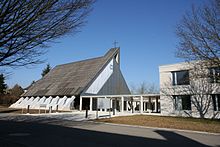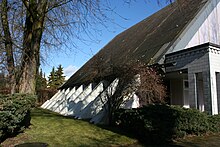St. Francis (Bassersdorf)
The Church of St. Franziskus is the Roman Catholic parish church of Bassersdorf in the Zurich Unterland . It is located in Bassersdorf on Äusseren Auenstrasse 2 . What is special about the church is that it is the first of the 16 Fastenopfer churches that have been preserved .
history
prehistory
In the Middle Ages , Bassersdorf belonged to the parish of Kloten together with Dietlikon and Wallisellen . After the Reformation in Zurich, Catholic worship was banned and the church in Bassersdorf was used for Reformed worship. When the daily statute was held in Zurich in 1807 , the so-called Edict of Tolerance came about , which allowed Catholic services for the first time, albeit with a local restriction. In 1833 Catholic services could be celebrated in Fraumünster Zurich. In 1842 the Augustinian Church was made available to the Catholics living in Zurich . When the Catholics living in Zurich protested against the infallibility dogma on June 8, 1873, the majority of them converted to the newly founded Christian Catholic Church, which meant that those who remained in the Roman Catholic Church had to build a new church. Thus, in 1874, the St. Peter and Paul Church in Zurich-Aussersihl was built, which became the mother parish of the city and region of Zurich, to which Bassersdorf also belongs. The Catholics who lived in Bassersdorf attended Sunday mass in Graftal from 1910, but religious instruction was given to the children in Bassersdorf. When a mission station was set up in Kloten in 1942 and the Christ the King's Church was later built, Bassersdorf was assigned to Kloten.
Development and construction history
When building activity began in Bassersdorf after the Second World War , so that the population more than doubled from 2,143 inhabitants in 1950 to 5,590 in 1970, the Christkönig Kloten parish in Bassersdorf first moved to the old secondary school building and later to the school's singing hall Mösli services celebrated. After the new Christ the King's Church and parish center had been inaugurated in Kloten in 1972, the desire for a church of its own also arose in Bassersdorf. Since the financial situation of the parish was still limited due to the construction of the center in Kloten, those responsible decided to implement a provisional solution with a so-called Fastenopfer Church. Fastenopfer churches were built with the support of the Fastenopfer aid organization and allowed diaspora congregations with little financial resources to build a church anyway. The Church of St. Franziskus in Bassersdorf is a building made of prefabricated elements, as is the case with the other three Fastenopfer churches in the region, the Brother Klaus Church in Volketswil, the Heilig Geist Church in Wetzikon and the one originally for the Heilig parish -Kreuz Zurich built, now in Wallisellen for the Free Evangelical community established Titus Church on the application came. Only around nine months after the groundbreaking on April 19, 1973, the Bishop of Chur , Johannes Vonderach, consecrated the Bassersdorf church on December 15, 1973 and consecrated it to St. Francis of Assisi. The farmhouse that belongs to the property was renovated in 1978 so that it could be used as a parsonage, whereupon parish vicar Leo Ehrler moved from Kloten to Bassersdorf to Bahnhofstrasse in 1979 . 13 relocated. In 1983, Bishop Johannes Vonderach appointed the parish vicariate, which was still under canonical law under the pastor of Kloten, as an independent parish of St. Franziskus, which has since been responsible for the communities of Bassersdorf and Nürensdorf.
In 1988 an extension was built that was attached to the church. It was not only used for church but also for secular occasions such as meetings of the political community in Bassersdorf and was also rented to third parties.
In 2012, the parish decided together with the parish of Kloten-Bassersdorf-Nürensdorf to renovate the Fastenopfer church and to add a parish center to the existing premises. To this end, a study contract was initially advertised. A jury, consisting of representatives of the parish and experts, recommended the Hand in Hand project by the architects Susann Vécsey and Christoph Schmidt, Basel, for further processing of the five submitted works . On April 14, 2014, the parish assembly approved the building loan for the renovation of the church and the expansion of the parish center. The Franziskuszentrum , which was built between 2015 and 2016, complements the Fastenopferkirche from 1973 and the first extension from 1988 to form an ensemble that is grouped around a newly created inner courtyard. In the years 2016 to 2017 the church was redesigned by dismantling the original parish rooms in the church building from 1973 and converting the entire building into a single church space. On February 5, 2017, Bishop Vitus Huonder blessed the newly designed church, including the Francis Center.
The parish of St. Franziskus in Bassersdorf belongs under constitutional law to the Catholic parish of Kloten, which includes the political communities Nürensdorf and Bassersdorf as well as Kloten. The latter two are looked after by the parish of St. Francis, while the parish of Christ the King of Kloten is exclusively responsible for the city of Kloten. With its 4,387 members (as of 2017), the parish of St. Franziskus Bassersdorf is one of the medium-sized Catholic parishes in the canton of Zurich.
Building description
Fastenopferkirche
The Church of St. Franziskus was built as a Fastenopferkirche according to plans by the architect Hanns Anton Brütsch from prefabricated elements on a rectangular floor plan. All parts of the church are constructed in such a way that they could have been dismantled and rebuilt elsewhere. Thanks to the gable roof , which was pulled down to the ground at a 45-degree angle, there was no need to erect side walls. The cantonal building insurance had requested structural adaptations during the construction of the Bassersdorf church, which is why the St. Franziskus church differs from the other Fastenopfer churches in some details. The load-bearing structure had to be made of concrete instead of wooden elements, which not only benefits fire protection, but also the longevity of the building. In addition, the stairs to the organ gallery were made wider and the walls were given a fire-proof paint. This type of Fastenopferkirche, which was first used in Bassersdorf, was called "New Type 1973". In the north-western part of the building, there were community rooms on three floors until the redesign in 2016, so that the building originally united the church and the parish center. The cladding with Eternit elements protects the church from the weather. The roof turret , which hides a bell, is closed with a cross. The bell was cast by H. Rüetschi , Aarau in 1973. It weighs 452 kg and sounds on the note a '.
Extension buildings and artistic design
On the northern side of the Fastenopfer Church is the extension from 1988, which supplemented the few parish rooms in the Fastenopfer Church. In a second stage between 2015 and 2016, the existing ensemble was expanded into a spacious parish center. The architects Susann Vécsey and Christoph Schmidt designed the new building in such a way that all three construction phases are now grouped around an inner courtyard that is reminiscent of a monastery cloister . A bistro , school and meeting rooms as well as the newly created offices offer space for parish life. The architects designed the new building to be functional and reserved. As a contrast and based on the bird sermon of the church patron, St. Francis, individual rooms were designed in the colors of some bird species and named after them. The inner courtyard was designed by the artist Isabel Bürgin, Basel. It took up the motto of the extension building (“Hand in Hand”) by designing the concrete slabs of the inner courtyard from abstract hands in different colors, which refers to the different nations and views of life that are at home in the Catholic parish of Bassersdorf. The fountain in the inner courtyard was also created by Isabel Bürgin; its most noticeable feature is cement structures installed in the well basin. The well symbolizes everything that comes from the depths and leads into the depths. The statement of the entire inner courtyard is: Church is community that comes from God and leads to God.
In the church building from 1973, the original parish rooms were dismantled during the redesign from 2016 to 2017 so that the church could be expanded without this being externally visible and now takes up the entire space of the building. The working day chapel on the ground floor behind the original choir wall was moved under the organ gallery and is connected to the church by doors. When the church was redesigned by the architects Susann Vécsey and Christoph Schmidt, the shape from 1973 was retained, but it was lightened with a new color scheme. The roof construction forms a triangle with the floor of the room and is thus reminiscent of the Trinity . A dark parquet floor emphasizes the festive character of the church interior. The chancel was redesigned in 2017 by Maria Jesus Fernandez, Aldenhoven . The popular altar and ambo have been restored and a new Easter candle stand and a lecture cross have been added. In the middle of the new, three-part choir wall there is an oak column with the tabernacle . The column commemorates St. Francis, who in a vision of Pope Innocent III. the collapsing church supports.
organ
The instrument, which has been installed in Bassersdorf since December 1974, was built by organ builder Winfried Albiez in 1972 as an interim organ for the Brother Klaus church in Zurich-Unterstrass. In 1994 the organ was revised by Mathis Orgelbau .
|
|
|
|||||||||||||||||||||||||
literature
- Episcopal Ordinariate Chur (ed.): Schematism of the Diocese of Chur. Chur 1980.
- State Archives of the Canton of Lucerne: Signature PA 1202.
Web links
Individual evidence
- ↑ a b Bischöfliches Ordinariat Chur (Ed.): Schematismus. P. 219.
- ↑ Josef Hürlimann: Chilebuech Wangen-Brüttisellen. P. 169
- ^ Website of the parish of Bassersdorf, section history. Retrieved March 4, 2014.
- ^ Website of the Catholic Church in Bern, section Heiliggeist Belp. Retrieved March 4, 2014.
- ↑ State Archives of the Canton of Lucerne: Signature PA 1202.
- ^ Website of the parish of Bassersdorf, section history. Retrieved March 4, 2014.
- ^ Zürcher Unterländer: The other center is ready. February 2, 2017, p. 5.
- ^ Website of the Bassersdorf parish, section Room for everyone. ( Memento of the original from April 27, 2014 in the Internet Archive ) Info: The archive link was inserted automatically and has not yet been checked. Please check the original and archive link according to the instructions and then remove this notice. Retrieved March 4, 2014.
- ^ Website of the parish Bassersdorf. Information section. Retrieved April 27, 2014.
- ^ Zürcher Unterländer: The other center is ready. February 2, 2017, p. 5.
- ^ Website of the Bassersdorf parish, History section.Retrieved on March 4, 2014.
- ↑ Catholic Church in the Canton of Zurich (Ed.): Annual Report 2017, p. 83.
- ↑ State Archives of the Canton of Lucerne: Signature PA 1202.
- ^ Archives of the parish
- ^ Zürcher Unterländer: The other center is ready. February 2, 2017, p. 5.
- ^ Organ directory Switzerland and Liechtenstein, section Catholic Church St. Franziskus Bassersdorf ZH. Retrieved March 7, 2017.
Coordinates: 47 ° 26 '27.1 " N , 8 ° 37' 39" E ; CH1903: 689676 / 255132




